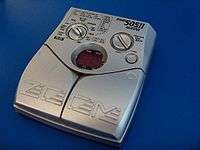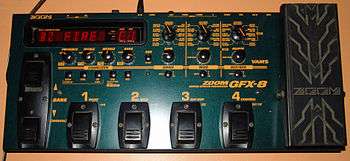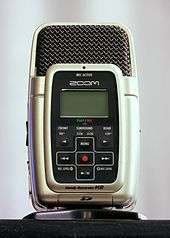Zoom Corporation
Zoom is a Japanese audio company that is distributed in the U.S. under the name Zoom North America, in the UK by Zoom UK Distribution Limited, and in Germany by Sound Service GmbH. Zoom produces effects pedals for guitars and basses, recording equipment, and drum machines. The company has become known for producing handheld recorders, audio for video solutions, inexpensive multi-effects and builds products around its own microchip designs.
| Public | |
| Traded as | JASDAQ: 6694 |
| ISIN | JP3411820008 |
| Industry | Audio equipment |
| Founded | 1983 |
| Headquarters | Tokyo, Japan |
Key people | Michihito Nozokido (president) |
| Products | Multi-effects, amps, etc |
| Website | zoom-na |
Products
Effect processors
Guitar effect processors

GFX-8

At the time it was released, the GFX-8 was the flagship of the Zoom GFX series.
It has a solid steel dark green body with an opto-based pedal on the right and red LED display on the top left. It uses the Variable Architecture Modeling System (V.A.M.S) technology.[7] In general, there are three main internal modules: for drive, for modulation and for delay. The unit allows a high level of distortion customization by using specialized software. It also allows the use of external distortion. The technology used in the unit does not allow full reordering of the effects but allows some of modulation effects like wah and phaser to be connected before or after the drive module. The drive module implements dynamic related effects like compressor, overdrive, distortion and fuzz. After the drive module, the noise gate module called ZNR (ZOOM Noise Reduction) is connected, followed by a parametric equalizer (presence, treble, middle, bass). The amp simulation module is connected next and allows various types of guitar amplifier simulations. The modulation module implements effects like wah, phaser, chorus, ring modulator, tremolo, vibrato, flanger and pitch shifter. The delay module is used to implement delay and reverb effects. Effects that require high processing power use modulation and delay module together. One such effect is the jam play effect, which allows, for example, a guitar player to play a rhythm guitar part and then play a solo part over it. The unit design is oriented toward ease of use by providing more knobs than usually found on such units, thus making the unit look more like a chain of effect boxes instead of the typical effect processor with a "few knobs many functions" type design. The unit has mature MIDI capabilities, allowing both control from an external sequencer or using the unit as a MIDI controller. The MIDI OUT can be configured to act as MIDI THRU.
Bass guitar effect processors
- 708II
- 607
- 506
- 506II
- B1
- B1x
- B1on
- B1Xon
- B2
- B2.1u
- B3
- B3n
- B9.1ut
- MS-60B
Acoustic guitar effect processors
- 504
- 504II
- A2
- A2.1u
- A3
Studio rack mountable effect processors
Digital recorders

- H1 Handy Recorder
- H1n Handy Recorder
- H2 Handy Recorder
- H2n
- H3-VR
- H4 Handy Recorder
- H5 Handy Recorder
- H4n Handy Recorder
- H6 Handy Recorder[13]
- F1-SP / F1-LP Field Recorder
- F4 Field Recorder
- F8 Field Recorder
- F8n Field Recorder
- MRS-1608[14]
- MRS-1266[15]
- MRS-1044[16]
- MRS-802[17]
- MRS-8
- MRS-4[18]
- PS-04
- PS-02[19]
- HD8 / HD8CD
- HD16 / HD16CD
- R8[20]
- R16[21]
- R24[22]
- Q2HD
- Q3
- Q3HD
- Q4
- Q4n
- Q8HD
Rhythm machines
- RT-123
- RT-223
- RT-323
- RT-234[23]
- MRT-3
- MRT-3b
- SB-246
- ST-224
Guitar amplifiers
- FIRE-36M
- FIRE-18M
- FIRE-36
- FIRE-18
- FIRE-7010
Audio interfaces
- TAC-2[26]
- TAC-2R
- TAC-8
- UAC-2
- UAC-8
References
- "Zoom GM200". Sound On Sound. August 2000. Archived from the original on 7 June 2015.
- "Zoom ZFX Control Package". Sound On Sound. September 2008. Archived from the original on 6 June 2015.
- Walden, John (October 1998). "Zoom 503". Sound On Sound. Archived from the original on 2 January 2016.
- White, Paul (September 1995). "Zoom 1010 Player". Sound On Sound. Archived from the original on 7 June 2015.
- White, Paul (April 1994). "Zoom 9050S". Sound On Sound. Archived from the original on 15 September 2014.
- White, Paul (April 1995). "Zoom 9150". Sound On Sound. Archived from the original on 6 June 2015.
- "Zoom GFX8". Sound On Sound. September 2000. Archived from the original on 9 June 2015.
- "Zoom RFX2200 & RFX1100". Sound On Sound. March 2005. Archived from the original on 2 January 2016.
- "Zoom RFX1000 & RFX2000". Sound On Sound. January 2000. Archived from the original on 27 May 2012.
- "Zoom Studio 1201". Sound On Sound. September 1997. Archived from the original on 14 September 2014.
- "Zoom 1202". Sound On Sound. February 1995. Archived from the original on 7 June 2015.
- "Zoom Studio 1204". Sound On Sound. October 1996. Archived from the original on 6 June 2015.
- "Zoom H6". Sound On Sound. November 2013. Archived from the original on 8 June 2015.
- "Zoom MRS1608". Sound On Sound. January 2005. Archived from the original on 9 June 2015.
- "Zoom MRS1266". Sound On Sound. February 2003. Archived from the original on 9 June 2015.
- "Zoom MRS1044". Sound On Sound. January 2002. Archived from the original on 9 June 2015.
- "Zoom MRS802". Sound On Sound. July 2003. Archived from the original on 6 June 2015.
- "Zoom MRS4". Sound On Sound. September 2003. Archived from the original on 6 June 2015.
- "Zoom PS02". Sound On Sound. February 2001. Archived from the original on 8 June 2015.
- "Zoom R8". Sound On Sound. April 2012. Archived from the original on 6 June 2015.
- "Zoom R16". Sound On Sound. September 2009. Archived from the original on 13 May 2015.
- "Zoom R24". Sound On Sound. January 2011. Archived from the original on 8 June 2015.
- "Zoom RhythmTrak 234". Sound On Sound. May 1998. Archived from the original on 8 June 2015.
- Peck, Emily. "The best and most creative musical tech for your kids". Retrieved 2018-06-28.
- Orf, Darren. "I Want to Play With This Bewildering Bluetooth Tambourine". Gizmodo. Retrieved 2018-06-28.
- "Zoom TAC-2". Sound On Sound. December 2014. Retrieved 26 June 2018.
Further reading
- "Zoom Rhythmtrack RT-123". Future Music. No. 83. Future Publishing. June 1999. p. 84. ISSN 0967-0378. OCLC 1032779031.
- "Zoom 507". Future Music. No. 59. Future Publishing. August 1997. p. 37. ISSN 0967-0378. OCLC 1032779031.


